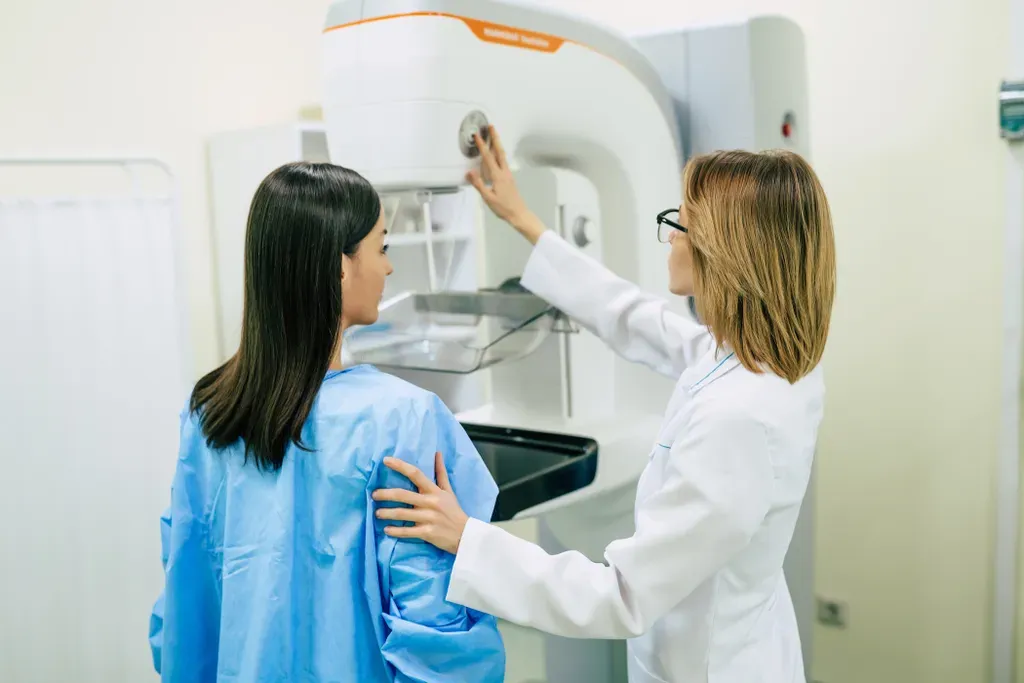
About 3D Mammogram
Definition
How the mammogram is an x-ray picture of the breasts. It is used to find breast tumors and cancer.
How Test is Performed
You will be asked to undress from the waist up. You will be given a gown to wear.
Depending on the type of equipment used, you will sit or stand.
One breast at a time is rested on a flat surface that contains the x-ray plate. A device called a compressor will be pressed firmly against the breast. This helps flatten the breast tissue.
The x-ray pictures are taken from several angles. You may be asked to hold your breath as each picture is taken.
You may be asked to come back at a later date for more mammogram images. This does not always mean you have breast cancer. Your health care provider may simply need to recheck an area that could not be clearly seen on the first test.
TYPES OF MAMMOGRAPHY
Traditional mammography uses film, similar to routine x-rays.
Digital mammography is a newer technique:
- It is now used in many breast screening centers.
- It allows the x-ray image of the breast to be viewed and manipulated on a computer screen.
- It may be more accurate in younger women with dense breasts. It has not yet been proven to help reduce a woman's risk of dying of breast cancer compared to film mammography
Three-dimensional (3D) mammography is a type of digital mammography.
Researchers do not yet know whether 3D mammography is more or less accurate than standard mammogram.
How to Prepare for the Test
DO NOT use deodorant, perfume, powders, or ointments under your arms or on your breasts on the day of the mammogram.
These substances may hide the images. Remove all jewelry from your neck and chest area.
Tell your provider and the xray technologist if you are pregnant or breastfeeding, or if you've had a breast biopsy.
How the Test Will Feel
The compressor surfaces may feel cold. When the breast is pressed down, you may have some pain. This needs to be done to get good quality images.
Why the Test is Performed
When and how often to have a screening mammogram is a choice you must make. Different expert groups do not fully agree on the best timing for this test.
Before having a mammogram, talk to your provider about the pros and cons of having the test. Ask about:
- Your risk for breast cancer
- Whether screening decreases your chance of dying from breast cancer
- Whether there is any harm from breast cancer screening, such as side effects from testing or overtreatment of cancer when it's discovered
Mammography is performed to screen women to detect early breast cancer when it is more likely to be cured.
Mammography is generally recommended for:
- Women starting at age 40, repeated every 1 to 2 years. (This is not recommended by all expert organizations.)
- All women starting at age 50, repeated every 1 to 2 years.
- Women with a mother or sister who had breast cancer at a younger age should consider yearly mammograms. They should begin earlier than the age at which their youngest family member was diagnosed.
Mammography is also used to:
- Follow a woman who has had an abnormal mammogram.
- Evaluate a woman who has symptoms of a breast disease. These symptoms may include a lump, nipple discharge, breast pain, dimpling of the skin on the breast, changes of the nipple, or other findings.
Normal Results
Breast tissue that shows no signs of a mass or calcifications is considered normal.
What Abnormal Results Mean
Most abnormal findings on a screening mammogram turn out to be benign (not cancer) or nothing to worry about. New findings or changes must be further evaluated.
A radiology doctor (radiologist) may see the following types of findings on a mammogram:
- A well-outlined, regular, clear spot (this is more likely to be a noncancerous condition, such as a cyst)
- Masses or lumps
- Dense areas in the breast that can be breast cancer or hide breast cancer
- Calcifications, which are caused by tiny deposits of calcium in the breast
tissue (most calcifications are not a sign of cancer)
At times, the following tests are also needed to further examine mammogram findings:
- Additional mammogram views, called magnification or compression views
- Breast ultrasound
- Breast MRI exam (less commonly done)
Comparing your current mammogram to your past mammograms helps the radiologist tell whether you had an abnormal finding in the past and whether it has changed.
When mammogram or ultrasound results look suspicious, a biopsy is done to test the tissue and see if it is cancerous. Types of biopsies include:
- Stereotactic
- Ultrasound
- Open
Risks
The level of radiation is low and any risk from mammography is very low. If you are pregnant and need to have an abnormality checked, your belly area will be covered and protected by a lead apron.
Routine screening mammography is not done during pregnancy or while breastfeeding.
Alternative Names
Mammography; Breast cancer - mammography; Breast cancer - screening mammography; Breast lump - mammogram; Breast tomosynthesis